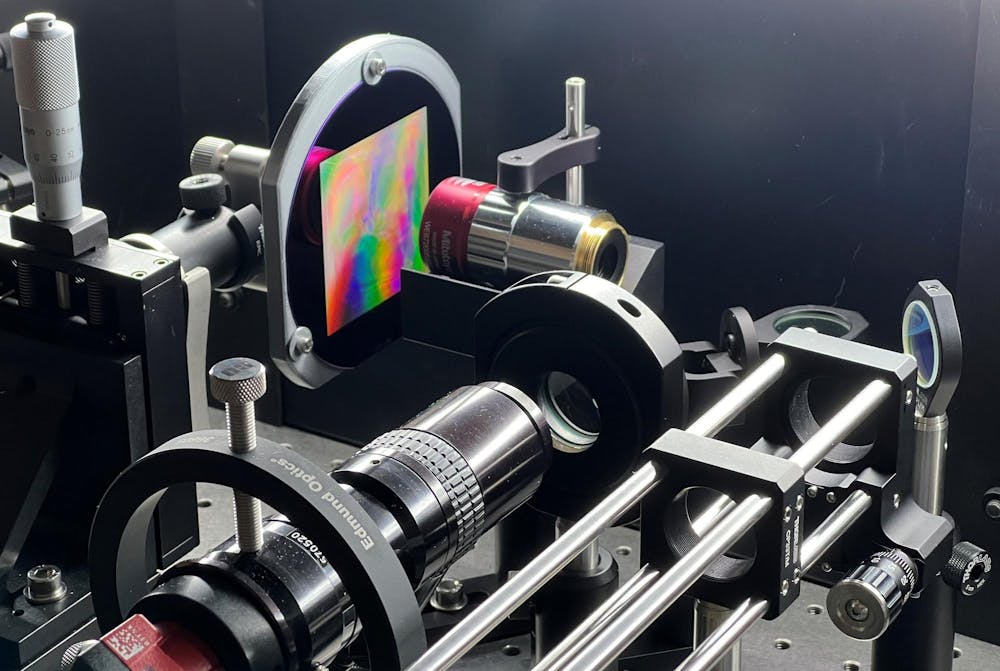If a scientist were to launch a spacecraft to reach a star or exoplanet tomorrow, it would take tens of thousands of years. But in collaboration with Delft University physicists, Brown researchers have designed a new technology that could help cut that travel time down to just 20 years, according to Associate Professor of Engineering Miguel Bessa.
In a Nature Communications article published in late March, researchers announced that they had created a more efficient way to design and manufacture lightsails — light-reflecting, lightweight membranes that can accelerate in the presence of light. These materials are carefully designed with tiny holes to minimize mass and enhance reflectivity.
When a powerful laser stationed on Earth shines onto a sail for about 10 minutes, “the light bounces off the lightsail,” Bessa explained, and the light’s pressure pushes the sail, and anything attached to it, into outer space. This effect is tied to a phenomenon known as the Doppler Shift, which is also the reason an ambulance siren changes pitch as it passes by.
The team’s lightsail weighs just one gram, which is about the mass of a jelly bean.
Bessa led the theoretical side of the research from Brown, while Richard Norte, an associate professor at Delft University of Technology in the Netherlands, ran the experimental side. The two began the project three years ago when Bessa was working in the Netherlands.
According to Bessa, the challenge is to make the sail “as thin and light as possible, and at the same time as reflective as possible for the entire time that the laser will be shining on the lightsail.”
Norte described the fabrication process as similar to “extremely delicate ‘glass blowing.’”
In that one-gram structure is a camera and a lightsail made of single-layer silicon nitride. Norte likened the lightsail to a sheet “1,000 times thinner in diameter” than “a hair on your body.”
Bessa and the researchers tried to find the optimal shape of the holes in the lightsail to ensure the maximum reflectivity from the laser.
In past iterations, lightsail holes were carved using expensive electron beams. But the researchers found a more affordable and efficient alternative: lithography.
To ensure the lightsail was reflective, strong and light enough, the team used artificial intelligence that could “simulate the lightsail in the computer,” Bessa said. The program used optimization to “come up with a new design that we didn’t know before.”
The project draws inspiration from the Breakthrough Starshot Initiative, tackling one of the initiative’s major technological challenges. The Breakthrough Starshot Initiative was launched in 2016 by Stephen Hawking and Yuri Milner, which aims to send lightsails to nearby star systems within 20 years of launch.
Although the research is still in its early days, Bessa is already thinking about future uses for the lightsail. “We are wondering if it’s possible to levitate objects with light,” he said.
For the sail to actually reach space, a major agency like NASA or a private company such as SpaceX would need to adopt and scale the project, Bessa said.
“Achieving real-world use, particularly for interstellar travel, will require much more effort from many teams,” said Shunyu Yin GS, an engineering PhD student and author on the paper.
Ognjen Ilic, an engineering professor at the University of Minnesota who was not involved in the study, wrote in an email to The Herald that “this is a beautiful piece of work and a significant result for the development of photonic lightsails.”
“Building on the approach that the authors successfully demonstrated will be a key next step for scaling up the technology,” Ilic added.

Leah Koritz is a senior staff writer covering science & research. Leah is from Dover, Massachusetts and studies Public Health and Judaic Studies. In her free time, Leah enjoys hiking, watching the Red Sox and playing with her dog, Boba.





